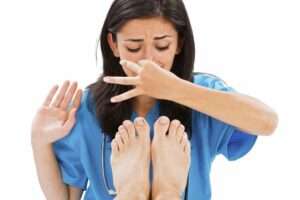Smelly Feet: Causes and Solutions for Foot Odor
If you’re dealing with smelly feet, you’re not alone. The condition, medically known as bromhidrosis, is common and can affect people of all ages, from kids to adults. The good news is that smelly feet are usually caused by an underlying issue, and with the right treatment, the odor can be eliminated.

Why Do Feet Become Smelly?
The primary reason feet become smelly is due to the combination of sweat, bacteria, and fungi. Each foot has over 250,000 sweat glands, producing up to 300-400 mL of sweat per day. When sweat combines with the bacteria and fungi that naturally live on your skin, shoes, and socks, it creates a warm, moist environment that encourages the growth of these microorganisms. Their waste products produce the foul odor associated with foot odor.
In addition to the unpleasant smell, the growth of bacteria and fungi can lead to infections such as athlete’s foot, fungal toenails (onychomycosis), itchy blisters, and other skin rashes.
Symptoms of Smelly Feet
The smell associated with bromhidrosis is often described as a mouldy cheese-like odor. Depending on the type of infection, it may have a sweet aspect. Other common symptoms of smelly feet include:
- Moist, wet feet
- Rashes
- Blistering or bubbling of the skin
- Fungal infections, such as athlete’s foot or toenail fungus
Treating Smelly Feet
The key to treating smelly feet is addressing the root cause: the bacteria and fungi that thrive in the moist, warm environment of your shoes. These pathogens can be treated using antifungal and antibacterial creams, sprays, or ultraviolet light.
Here are some tips for managing and preventing foot odor at home:
Foot Creams and Powders: Use antifungal creams or powders to eliminate the fungus that contributes to foot odor. These products help to dry the feet and kill harmful microorganisms.
Regular Hygiene: Shower regularly, especially after activities that cause sweat. Make sure to dry your feet thoroughly, as bacteria thrive in moist conditions.
Changing Footwear and Socks Frequently: Wearing clean socks and rotating between different pairs of shoes can reduce moisture and bacteria buildup.
Wear Open-Toed Shoes: During warmer weather, consider wearing sandals or other open-toed shoes to allow your feet to breathe.
Washing Your Shoes: Clean your shoes regularly by washing them in the machine or using disinfectant sprays to kill bacteria and fungi.
Methylated Spirits: A more natural disinfectant, methylated spirits can help clean your feet and shoes, killing the odor-causing germs.
It’s important to note that simply using deodorants or sprays will not solve the underlying issue. They may temporarily mask the smell, but they do not address the bacterial or fungal infection that is causing the odor.
Deodorising and Disinfecting Shoes
Fungal toenails (onychomycosis) are a common concern related to smelly feet and can be difficult to treat with over-the-counter products. The best solution for fungal toenails is laser therapy, which has proven effective in eliminating the fungus. However, even after successful treatment, relapse can occur due to reinfection from contaminated shoes.
To ensure that your shoes are free from odor-causing pathogens, it’s essential to disinfect them properly. At Leading Health Podiatry, we use advanced ultraviolet light technology to directly target the bacteria and fungi deep within your shoes. This method eliminates germs more effectively than traditional chemical sprays, ensuring that your footwear is sanitized and deodorized.
Conclusion
Smelly feet can be an embarrassing and frustrating problem, but with the right treatment, you can eliminate the odor and prevent future issues. By addressing the root cause of the odor, practicing good hygiene, and using appropriate treatments such as antifungal creams, powders, and ultraviolet light technology for your shoes, you can say goodbye to foot odor and enjoy fresher, healthier feet. If foot odor persists or is accompanied by other symptoms like infections or pain, it’s essential to consult a podiatrist for further evaluation and treatment.
